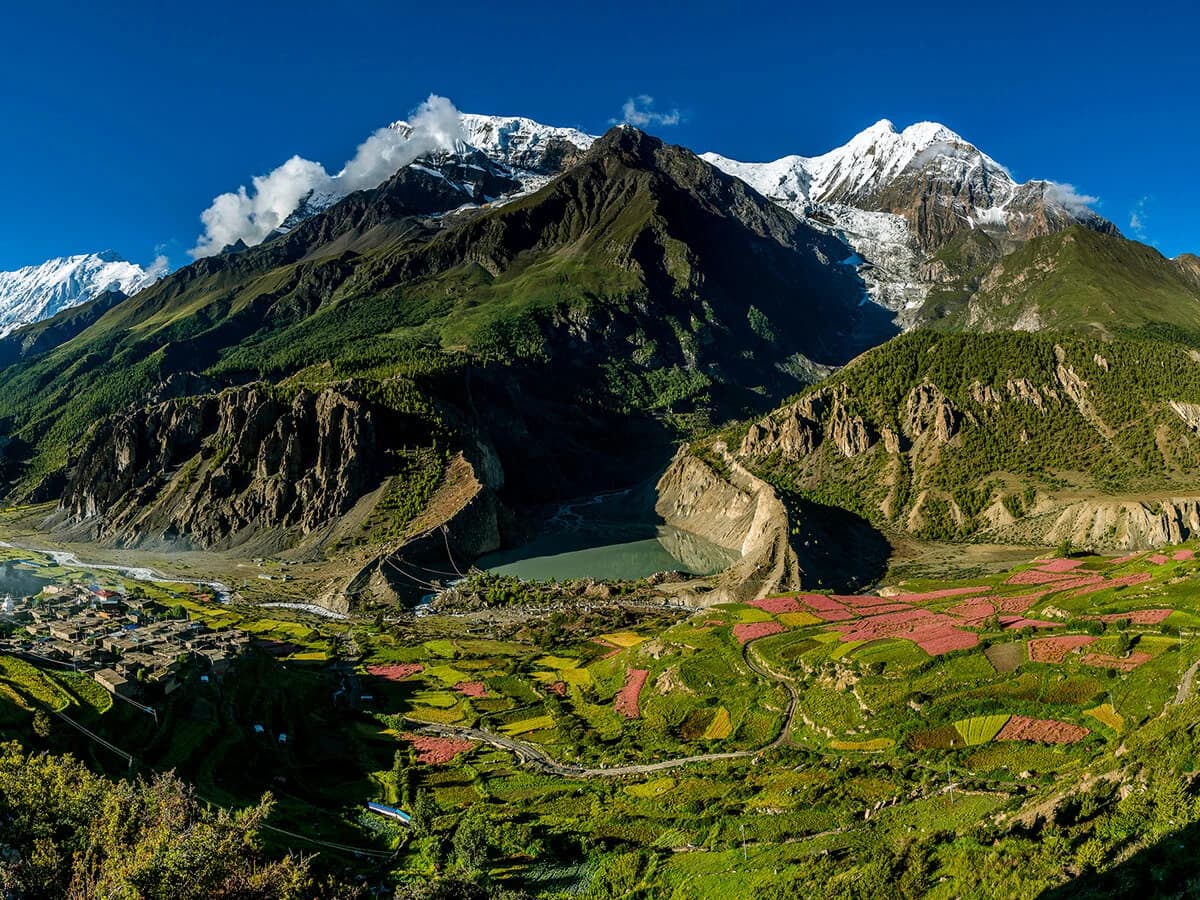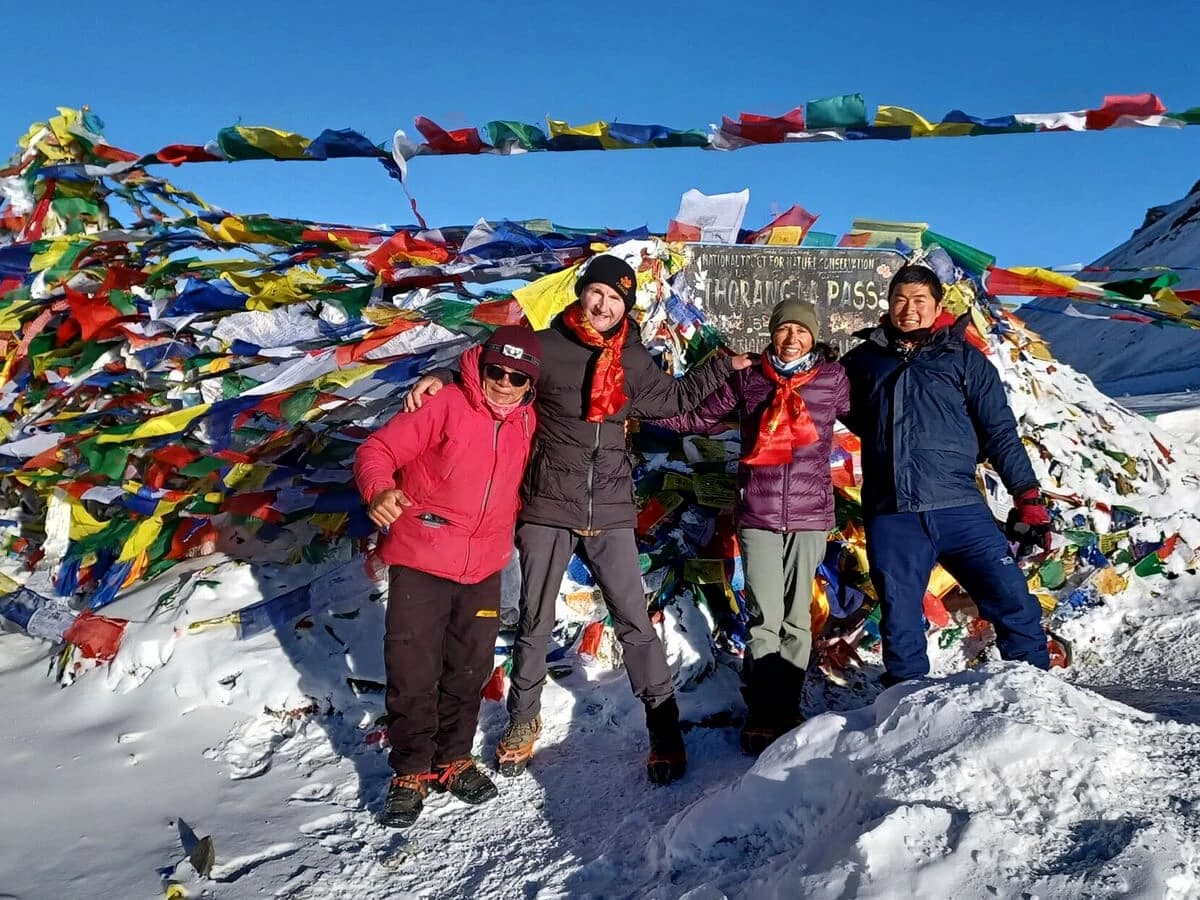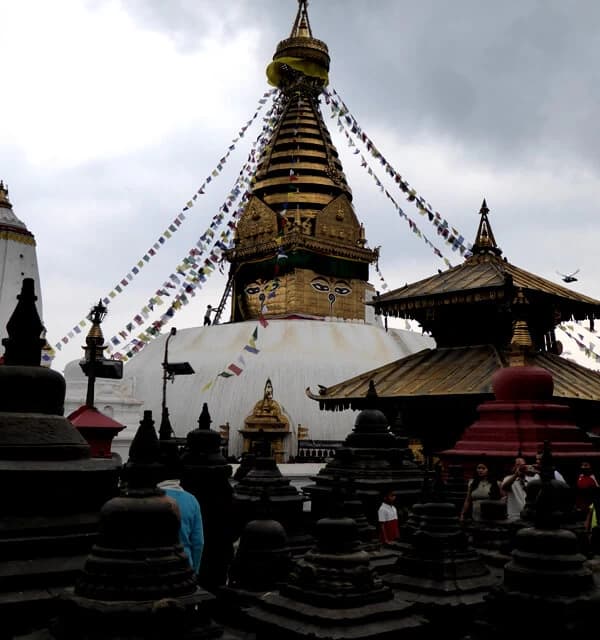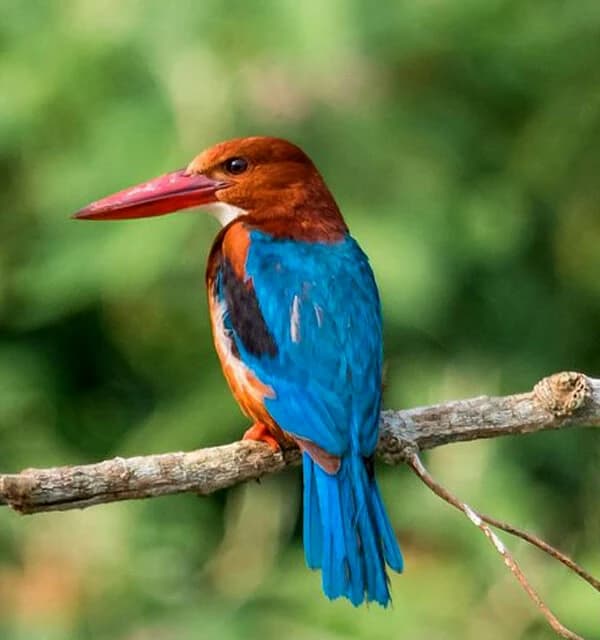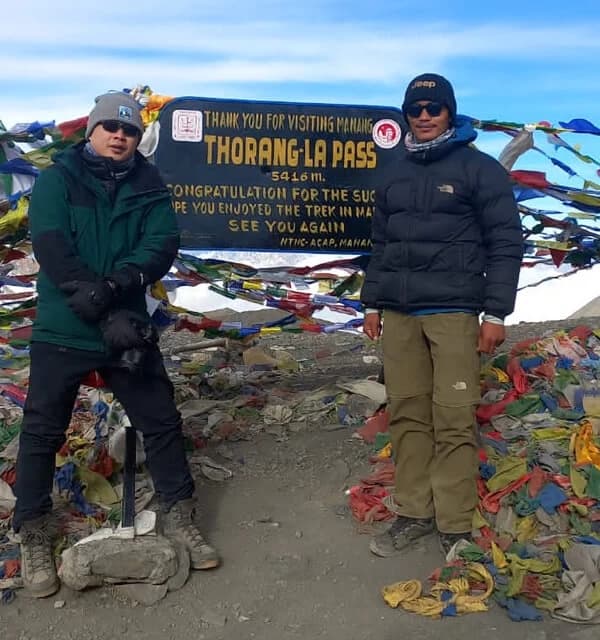Annapurna Circuit Trek, an epic journey to the Nepal’s majestic Himalaya of entire Annapurna range where ever-flowing mountain rivers fascinatingly whispers, mountain air touches you gently and its matchless beauty region steals your heart wonderfully with experiencing unique diverse cultures and encountering mind and soul soothing lively heritages and religious sites along the route that merely starts at 600 meters and reaches high at 5000 meters.
Annapurna Circuit Trek - 14 Days
Key Highlights of Annapurna Circuit Trek that make it one of the world’s greatest treks
- Thorong La Pass (5,416 m / 17,769 ft): Experience the highest point of the trek and one of the world’s highest trekking passes. Crossing it is both challenging and thrilling.
- Diverse Landscapes: Start the trek from subtropical forests and terraced farmlands to the arid Tibetan-like deserts. The trek provides unbelievable diversity in scenery within a few days of hiking to the Annapurna Circuit.
- Spectacular Mountain Views: Spectacular Views of Annapurna I, II, III, IV, Gangapurna, Tilicho Peak, Dhaulagiri, Machhapuchhre (Fishtail), and Manaslu.
- Manang Valley: Manang, itself a very beautiful village, is a culturally rich Tibetan-influenced settlement with Buddhist monasteries and other shrines.
- Muktinath Temple: Muktinath is an important religious pilgrimage site of both Hindu and Buddhist devotees, symbolizing spiritual harmony and cultural significance.
- Kali Gandaki Gorge: The deepest gorge in the world, situated between the Annapurna and Dhaulagiri ranges, offering surreal landscapes.
- Hot Springs at Tatopani: A perfect place to soak yourself in a natural hot spa to relax your muscles after a long mountain hike.
- Ghorepani and Poon Hill: A very famous place for stunning sunrise views over the Annapurna and Dhaulagiri ranges, with golden light sweeping across the peaks.
- Cultural Diversity: Encounter a unique blend of ethnic groups, including Brahmins, Gurungs, Magars, Thakalis, and Manangis, each with distinct traditions, architecture, and local hospitality.
- The Lake City of Pokhara: The country’s most beautiful city is a perfect place to relax and rejuvenate after the trek. Pokhara also provides the start point of many other beautiful Annapurna Treks.
- Geological Diversity: In this trek, you will encounter vast geographical and cultural diversity. If you start your trek at Besisahar, it is just 700 meters, and you will reach the height of 5416 meters at the high Thorong La Pass.
Trek the Annapurna Circuit Overview
The Annapurna Circuit Trek, a journey through Nepal’s Majestic Himalayas, is one of the most famous and iconic trekking routes in the world, located in the central Himalayas of Nepal. It offers trekkers an unparalleled combination of natural beauty, cultural richness, and physical challenge. With its diverse landscapes, vibrant local communities, and stunning vistas, the Annapurna Circuit remains a bucket-list trek for adventurers across the globe. This trip overview aims to provide insight into the Annapurna Round Trek.
The route goes through merely 600 meters high Besishahar and reaching up to 5000 meters high Annapurna Circuit Thorong La Pass offers a challenging but thrilling adventure with viewing mind-blowing scenery of the mountain peaks, seen closer includes the Annapurna Massif (from Annapurna I to IV), Mount Dhaulagiri, Machhapuchhre, Manaslu, Gangapurna, Hiuchuli, Tukuche Peak, Tilicho Peak, Pisang Peak, Thorong Peak, and Nilgiri Himal. Numerous other peaks of 6000 to 7000 meters in elevation rise from the Annapurna range.
Why Book this Trek with Wilderness Excursion?
- A dedicated and attentive support team for this trek
- Fair and best trip price without hidden cost for this Circuit Trek.
- Honest trip feedback and guest reviews from previous customers.
- We value your safety and satisfaction
- A fully documented trekking company for Trekking tours in Nepal.
- Easy booking and cancellation policy.
- Flexible and changeable Itinerary if necessary
What experiences can I anticipate on the Annapurna Trekking trail?
In the legendary 14-day trek of Annapurna Circuit, hiking in the traditional trekking route in Nepal that brings you around the Annapurna Massif, the most highlighted feature is the iconic mountain peaks. The trek is famed for its diversity of landscapes, ranging from tropical rice fields to alpine meadows and the Giant Himalaya. The ever-flowing mountain rivers roaring down through rock and builder, overlooking cliff and various trails offering elevated views of the gorgeous valley, hamlets. You can visit Buddhist monasteries, take a worthy side trip to the sacred caves of a great Buddhist master, where they meditated and got enlightenment. Glacial Lakes await your visit and elevate your trek more engaging experience.
The upper part of Manang and Mustang is arid land and lies under the rain shadow also offers great monsoon treks. Heading down from Mustang part to Tatopani, where your natural hot spa waits for you, and trek up to Ghorepani, walk through Asia’s biggest rhododendron forest walk and conclude the trek at Pokhara, the city of lakes.
There are two parts of the Annapurna Circuit, its high point, the Thorong La Pass at 5,416 meters (17,769 feet) apart this these two sections. The first part is from Besishahr in Lamjung to Manang Valley and Thorong La top, is the most challenging section of the trek. After leaving the Manang and crossing over Throng La, the trek descends on a pleasant trail to Muktinath in lower Mustang, and now, the road drives available if opting to end the trek and take a flight to Pokhara from Jomsom, in the south, and is surrounded by some of the highest peaks in the Annapurna range.
How does this Circuit Trek to the Annapurna Route change your life?
Absolutely, trekking to the Annapurna Circuit may bring changes in your life. A Chinese saying, “Traveling is Learning”. Travel profoundly changes a person by expanding their thought and perspective, leaving them "speechless" and then turning them into a "storyteller". Quotes like "The world is a book and those who do not travel read only one page" by Saint Augustine emphasize how travel broadens the mind and combats prejudice. Trekking to Annapurna provides learning and sharing insight way of living with minimal worldly material facilities in a remote mountain area, but a happy life.
Every corner of this trek to Annapurna will leave you Every corner of this Annapurna trek will leave you wordless; therefore, it offers matchless Himalayan wonders. Besides the adventure, a unique experience of the Himalayan culture, Buddhist temples, and isolated traditional settlements, history adds much to the culture and spiritual dimensions. The journey to Annapurna fulfills the hunger for travel desire to get a true sense of accomplishment. Thus, it offers unmatched adventure wonders.
Why should I have two days at Manang? What is Manang famous for?
Manang Village lies at an altitude of 3500 meters. And the place provides a base for taking a side trip to Ice Lake, Gangapurna Lake. An extra day at Manang is scheduled for Acclimatization in our itinerary before heading to Thorong La Pass. Not just Manang, but all the places like Pisang (Upper Pisang offers great mountain view), Muktinath, Marpha, offers cultarul and religious insight and Ghorepani with Poon Hill Hike rewards you with a stunning view and landscapes, and as a popular trekking destination It lies in the Annapurna region, which is known for its breathtaking Himalayan scenery surrounded by towering mountains, including the Annapurna range.
Manang also provides the side trek start point of famous Tilichi Lake, Mesokanto La Pass (5120m | 16800 ft.), which provides a less crowded alternative route to Thorong La Pass (5416 m). Check out our Annapurna Circuit Trek with Tilicho Lake – a combined adventure trip.
Trip Cost or Budgeting the Annapurna Circuit Trekking.
There are several aspects that vary the trip cost, including the season, number of participants, the length of the tour, and whether you just hire a guide or also include a porter to carry your main pack. Wilderness Excursion (WE) highly suggests hiring a porter shared between two trekkers to carry (maximum 25 KG) your pack, which helps you hike comfortably even where the air is very thin.
Typically, the Annapurna Circuit Trek costs USD 1000 to 1500 per person for a fully supported guided trek. Choosing a trekking agency also affects the trip cost. Our cost for the year 2026 is still USD 999 per person, exclusive on a two or more people shared basis, including an expert Annapurna Trekking guide, three meals a day, and accommodation. A cost detail is provided in the inclusion and exclusion section.
-
Extra expenses and Potential additional costs on the Annapurna Circuit: We suggest you put aside USD 15 to 25 per day (make sure you change in while in the city for a better rate) for extra spending, such as a hot shower, charging devices, beverages, or a bottle that you may like to celebrate achieving the success of Thorong La Pass. You may like to leave a little tip at a restaurant or donate in monasteries, buy a souvenir, etc.
Other significant costs are: Optional gear rental or purchase (200 up to $ 900), tipping guides and porters ($10–$15 per day for guide and $5–$10 for porters). Be informed for higher prices for food and drinks at higher altitudes. -
Is a tipping guide and porter necessary?
Tipping is expected for the Annapurna Circuit guide and porter, but it is not compulsory, and the amount depends on your satisfaction and their performance and service. A common guideline to tip a trekking guide and for a porter, often paid in USD, EURO, or Nepali Rupee, usually on the last day you part with them. Read more about tipping your Sherpa and Porters.
Trekking Guide and Annapurna Circuit
The Annapurna Circuit Trek is definitely the most spectacular journey and a diverse trekking, but it is equally challenging and adventurous, going through the rugged and rough trail. Hiring a trained and professional guide is always a wise idea for a safer trip and achieving the Thorong Pass trek, navigating the way, and insightful knowledge sharing that enhances the travel.
Is hiring a porter necessary? How much is the cost?
Taking a porter is optional, whether you hire one or trek without. If you are on a tight budget, you can ask the company to customize the service to lower the trip price. Walking 100 miles carrying your heavy bag at high altitude can be challenging, so considering a strong porter helps trekking conveniently and is very supportive if the weather turns bad or any other disturbance, such as symptoms developing of altitude sickness and physical weakness, etc.
For independent trekkers seeking a porter who can also navigate the trail and communicate in basic English, the cost typically ranges from USD 20 to 25 per day. Want to learn more about the roles of guides and trekking porters? Here is information to continue reading in detail.
The length of Trek / Distance of Annapurna Entire Route and Itinerary
Embark on an epic journey to the Annapurna Circuit Trek with a total distance of approximately 160 to 230 kilometers (100 to 145 miles), depending on the starting and ending points of the trek. The route can be adjusted according to your preferences and time, but typically it takes around 12 to 21 days to complete it.
Our 14-day itinerary starts from Kathmandu, followed by a drive to Jagat tailored by Wilderness Excursion. Still, many other trekking companies offer trips starting at Bulbule and Bahun Danda – a traditional old route that was very fascinating during the late 90s and early 20s.
The old path became shorter with the road expansion. The trek is usually divided into multiple stages, with most trekkers starting from Besisahar and finishing in Pokhara, while others opt for starting from Chame and ending at Jomsom. Starting at Chame is only suggested for expert hikers. It is always advised to start the trek lower to get proper acclimatization. Read more about important information on: Tips on Making a Nepal Trek Successful and Enjoyable.
14 Days Annapurna Guided Trek Outline Itinerary with Day by Day Altitude Gain
| Day | Description of Activities | Altitude | Trekking / Time |
| 1 | From Kathmandu - Drive to Jagat | 1300 m | 4264 ft. | - |
| 2 | Trek from Jagat to Dharapani | 1960 m | 6429 ft. | 6 to 7 Hours Hike |
| 3 | Trek from Dharapani to Chame | 2710 m | 8888 ft. | 7 Hours Hike |
| 4 | Trek from Chame to Pisang | 3300 m |10824 ft. | 6 Hours Hike |
| 5 | Trek from Pisang to Manang | 3540 m | 11611 ft. | 6 Hours Hike |
| 6 | Acclimatization Day at Manang | 3540 m | 11611 ft. | Rest Day |
| 7 | Trek from Manang to Ledar | 4230 m | 13874 ft. | 5 to 6 Hours Hike |
| 8 | Trek from Ledar to Phedi / High Camp | 4600 m | 15088 ft. | 4 ro 5 Hours Hike |
| 9 | Trek from Phedi to Muktinath | 3,800 m | 12465 ft. | 7 to 8 Hours Hike |
| 10 | Trek to Muktinath to Marpha | 2670 m | 8758 ft. | 6 to 7 Hours Hike |
| 11 | Drive to Tatopani from Marpha | 1200 m | 3950 ft. | 4 Hours. |
| 12 | Trek to Ghorepani from Tatopani | 2850 m | 9360 ft. | 7 to 8 Hours Hike |
| 13 | Trek from Ghorepani to Hile - Pokhara | 800 m | 2624 ft. | 6 to7 Hours |
| 14 | Drive to Kathmandu from Pokhara | 1300 m | 4264 ft. | 6 to 7 Hours. |
Other treks around it that you may like to personalize with it:
There are several other treks and side trips around the Annapurna Circuit that allow you to personalize your great trip. You can end this trek at Jomsom, then take a flight to Pokhara if you find your time is limited to complete the Annapurna trek in 10 to 12 days. Besides this 14-day trekking that encircles the Annapurna massif, there are two other great side treks that you can consider combining with it:
- Nar Phu Valley Trek
- Tilicho Lake Trek
- Tilicho Lake and Mesokanto La Pass Trek
A typical day in the Annapurna Round Trip of 14 Days
A typical day on the Annapurna Circuit involves an early start, generally about 6:30-7:00 AM, with breakfast and re-packing your gear before starting the hike by 7:30 AM. Trekking goes on for several hours, with a midday break to have lunch at a teahouse restaurant, followed by more trekking to reach the place of overnight stay. In the evening, trekkers rest, enjoy tea, check the photos of the day, write an Annapurna Trekking journal, and socialize before dinner and a guide briefing for the next day, going to bed by 8:30 to 9:00 PM.
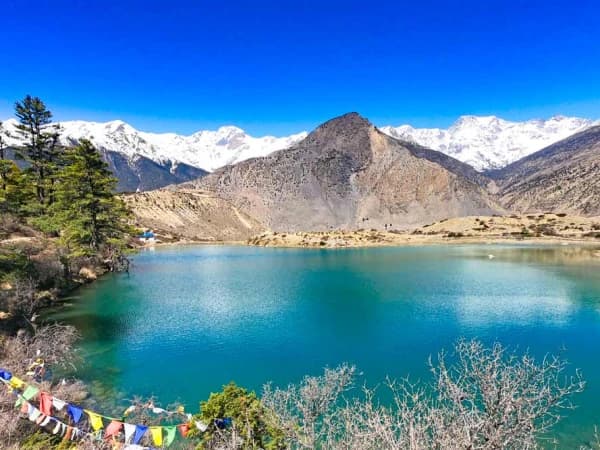

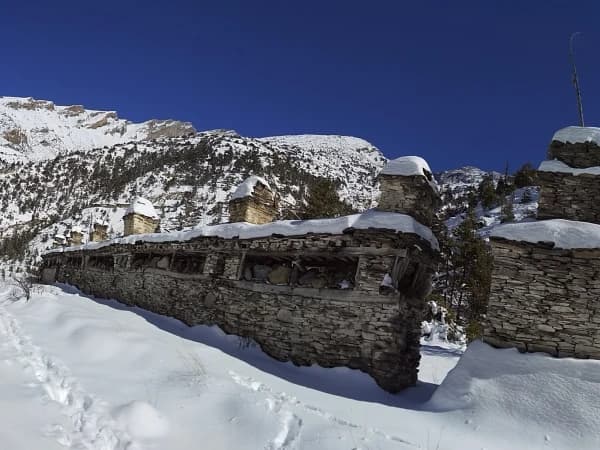
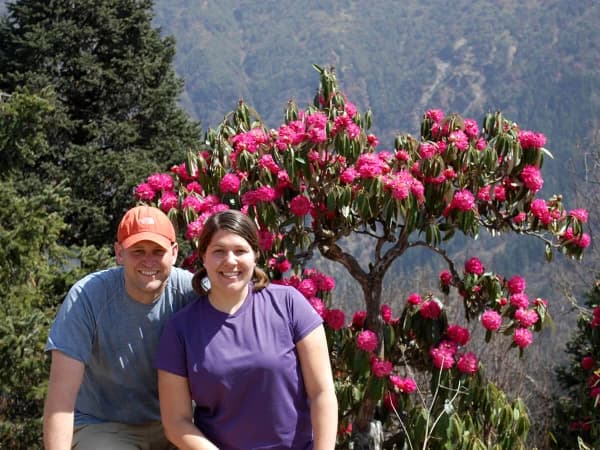
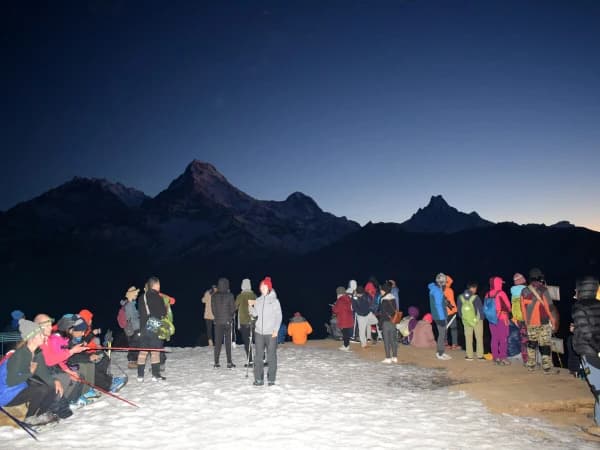
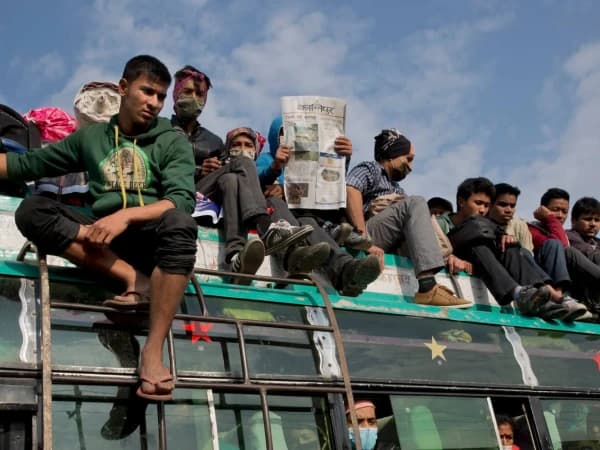
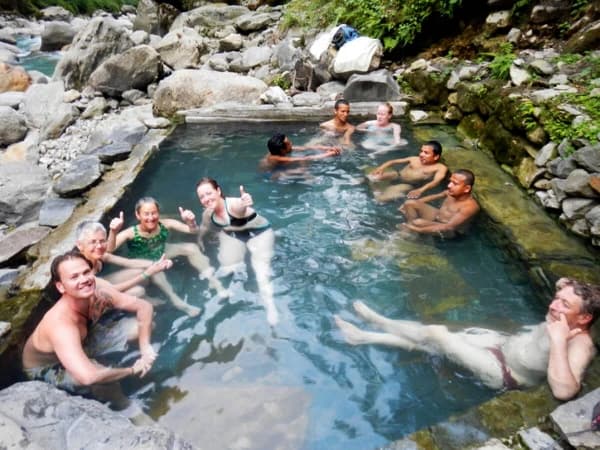
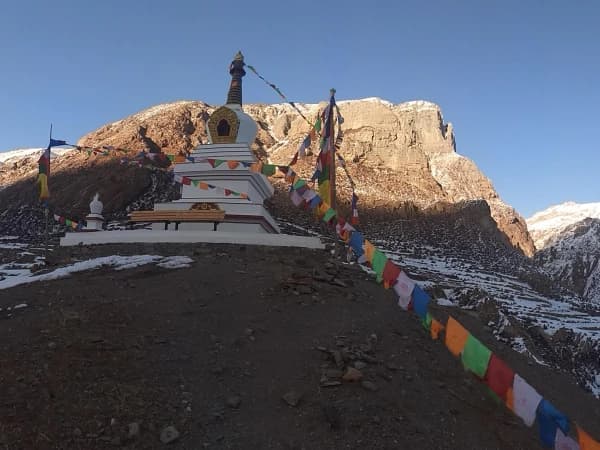
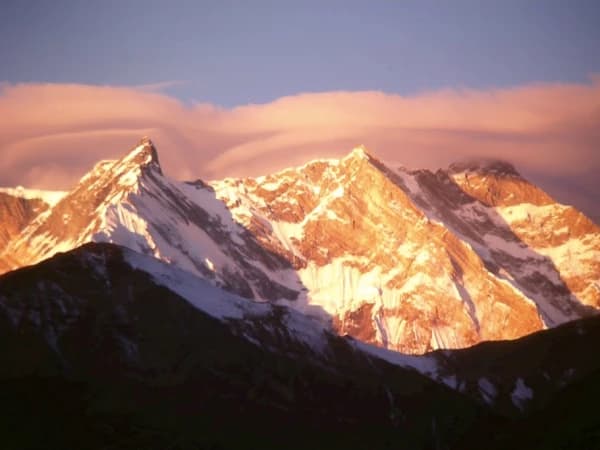

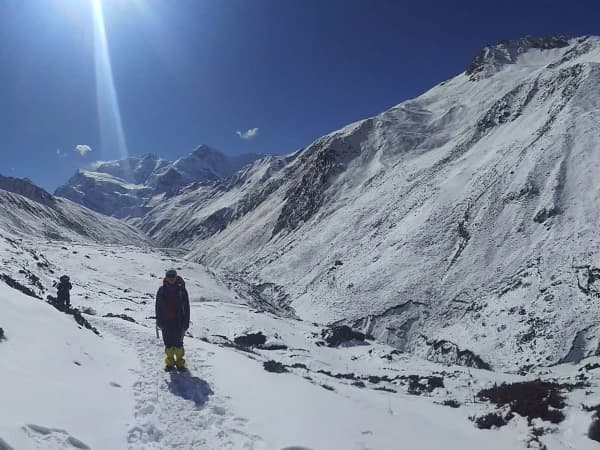

After breakfast; We set up off our journey into the hills on a winding road along the Trishuli River. On the way we admire terraced farm lands and beautiful huts. After reaching a juncture at Mugling, we move straight ahead towards Pokhara. At Dumre, we leave the previous road and head north to Besisahar, there will be connecting drive to Jagat by local jeep, total drive today will be around 8 hours. Alternatively, we can just drive to Bulbule or Khudi from Kathmandu to avoid long ride but that will add one extra day in your itinerary. Overnight in stay at Jagat. Meals included: Breakfast, Lunch Dinner.
Today, we leisurely start our trek. The trail from Jagat descends until it reaches the river and then continues through a lush forest. Further ascent leads to sharp-edged cliff facing the riverbank. En route, Chyamje comes into picture amidst the glorious backdrop of towering Annapurna mountain ranges, cross a suspension bridge; we climb steeply towards the slippery and physically challenging path to Sattale. On treading along a succession of rock-strewn trails, we descend to a grassy riverbank that leads to Tal. As we walk away from Tal, the path becomes rugged and winding. Then we approach steeply-forested village of Karte. Meandering along the waterfalls and cliffs, we finally reach Dharapani after crossing a suspension bridge. Overnight stay at Jagat. Meals included: Breakfast, Lunch Dinner.
Today we walk through a few forested ridges on our way to Chame, which is the headquarters of the Manang District. Throughout the trek we can admire amazing views of the Himalayas including Lamjung Himal, Annapurna II, and Annapurna IV (7,525m/24,688ft). On today’s trek we also come across small hot springs where we can dip in and soothe our aching muscles. Overnight stay in Chame. Meals included: Breakfast, Lunch Dinner.
The trails goes on through a steep and narrow path through a very dense forest will bring us to the dramatic curved rock face, rising 1500m from the river. This is probably the steepest part of the Marshyangdi Valley, so steep that the trail is carved into the vertical rock. After passing this last bit of rock, the valley opens up with majestic vistas. And right where the valley widens stands the Paungda Danda, a massive sloping rock face that rises over 5,000ft (1500m) above the trail. We trek for a while before reaching Lower Pisang where we spend the night. Meals included: Breakfast, Lunch and Dinner.
Today, we trek to Manang via Upper Pisang which is an off the beaten trail that guarantees excellent views of the beautiful landscape and the mighty mountains including Annapurna and Pisang on clear day. We begin to notice a contrast in the landscape and vegetation from today. The cold and dry climate also creates a much harsher environment. Our short visit to Braga monastery, the largest monastery in the entire district of Manang will be memorable. Overnight stay at Manang. Meals included: Breakfast, Lunch and Dinner.
As acclimatization is very important considering AMS. In order to keep fit on the trails that follow, we keep ourselves busy today with a short hike to either Bhojo Gumba or Gangapurna Lake. If we have the energy, we can even hike to Ice Lake. Overnight in stay at Manang. Meals included: Breakfast, Lunch and Dinner.
From Manang village, the trail crosses a stream, climbs to a village of Tenki and continues to climb out of the Marshyangdi Valley turning northwest up the valley of Jarsang Khola. The trail follows this valley northward, passing a few pastures and a scrub of juniper trees, as it steadily gains elevation. The trail further passes near the small village of Ghunsa, a cluster of flat mud roofs just below the trailhead. Now the trail goes through meadows where horses and yaks graze. After crossing a small river on a wooden bridge, the trail passes an ancient old Mani wall in a pleasant meadow and then reaches another small village of Leddar for overnight stay. Meals included: Breakfast, Lunch and Dinner.
It is an uphill walk to Thorang Phedi. After walking for some time we cross a suspension bridge and reach Ledar village. We ascend furthermore and pass through towering cliffs before reaching Thorang Phedi, the last village before Thorong La pass. On this trip we are rewarded with one of the best views of Mt. Gundang, Mt. Syagang, Thorung Peak and Mt. Khatungkan. The word Phedi in Nepalese is referred to as the foot of a mountain. Overnight stay at Thorong Phedi. Meals included: Breakfast, Lunch and Dinner.
Today; it is challenging and a thrilling day crossing over Thorong La pass, one of the highest passes in the world, will be our ultimate objective today. We will be crossing the pass from east to west (Manang to Muktinath) which is the easiest and safest direction. We get up around 4 o’clock in the morning and walk up the mountain. When we finally make it to the top, we realize that our journey was worth it. We can take a few photos before heading to Muktinath Valley at the foot of the Thorong La pass. Overnight stay at Muktinath. Meals included: Breakfast, Lunch and Dinner.
Muktinath is an important pilgrimage for both Hindus and Buddhists alike. In the morning, we pay our visit to a Vishnu Temple and a Gompa. Descending from Ranipauwa village down the steep and barren hillside, we tumble down toward Kagbeni and then to Jomsom finally arriving at Marpha. The trail today is quite surreal as we trek along a plateau above Kali Gandaki River, the world's deepest gorge. The barren landscape of this area resembles Tibet. Marpha is also famous as the apple capital of Nepal where one can enjoy different items made from apple. The local apple brandy of Marpha is famous all over Nepal. Overnight at Marpha. Meals included: Breakfast, Lunch and Dinner.
We drive to Tatopani today from Marpha to Tatopani meaning “Hot Spring” in Nepalese. We can enjoy the natural hot spa here after the big hike over Thorong La. Nepalses believe that the body ache and bone and vein related diseases like Arthritis are healed if you soak in hot spring. Overnight in Tatopani. Meals included: Breakfast, Lunch and Dinner.
We trek to Ghorepani leaving Kali Gandaki and head up the Ghar Khola valley. The trail leads us through a terraced farmland with mountains all around. We pass through the villages of Shikha and Chitre before reaching a beautiful rhododendron forest. When in bloom the rhododendron trees with its average height of up to 100" will be covered with pink or red flowers. Walking further we reach Ghorepani, a beautiful village located at a ridge top. Overnight stay in Ghorepani. Meals included: Breakfast, Lunch and Dinner.
An early morning hike to Poon Hill before dawn to catch a amazing sunrise over the Himalaya climb along the steep trail to the viewpoint of Poon Hill at 3,210 meter the most popular trekking destination of the Annapurna region. It is also a great viewpoint to enjoy the amazing views of Annapurna and Dhaulagiri ranges. The snowy peaks of the high mountains loom above and around us glowing in the morning light. After taking photographs, we return back to Ghorepani. After breakfast, we head Hile descend through rhododendron forests, pass by spectacular waterfalls. There will be our car/van waiting for us to drive to Pokhara. Meals included: Breakfast and Lunch.
Our Annapurna Circuit Trek now comes to an end with the Wilderness Excursion. You have choices to extend your stay in Pokhara to relax here or drive to Chitwan National Park for an awesome Jungle Safari Trip.
From Pokhara, you can also go to Lumbini – the birthplace of Sakyamuni Buddha. The tourist bus ticket is included if you are coming back to Kathmandu.
Wilderness Excursion (WE) aims to keep to the day-by-day itinerary of Annapurna Circuit trek detail as follows, even though there might be some flexibility because of local situations or other issues beyond our control. If this is the case, the trek leader will do everything possible to work out the changes to the itinerary in order to minimize your inconvenience.
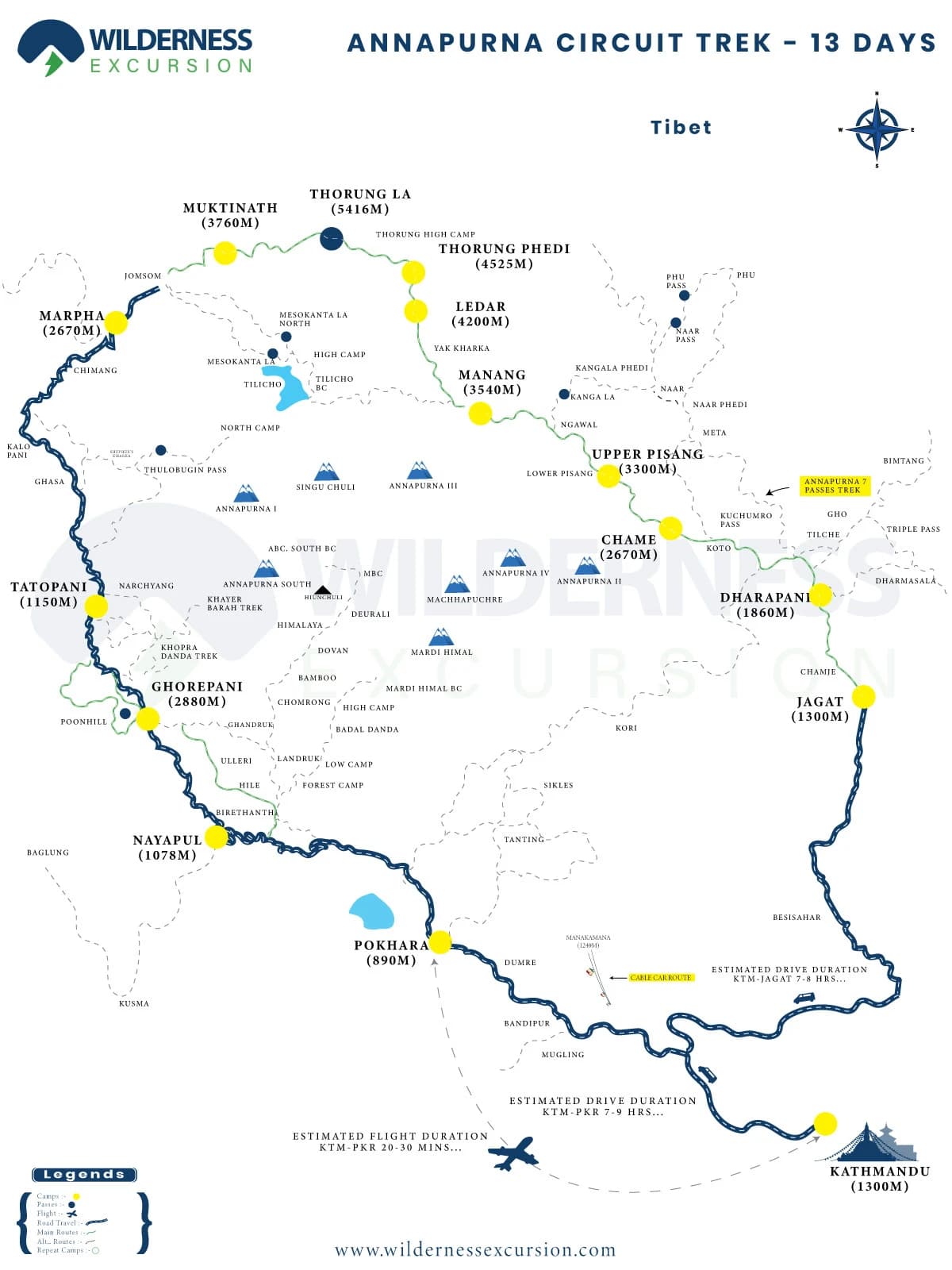
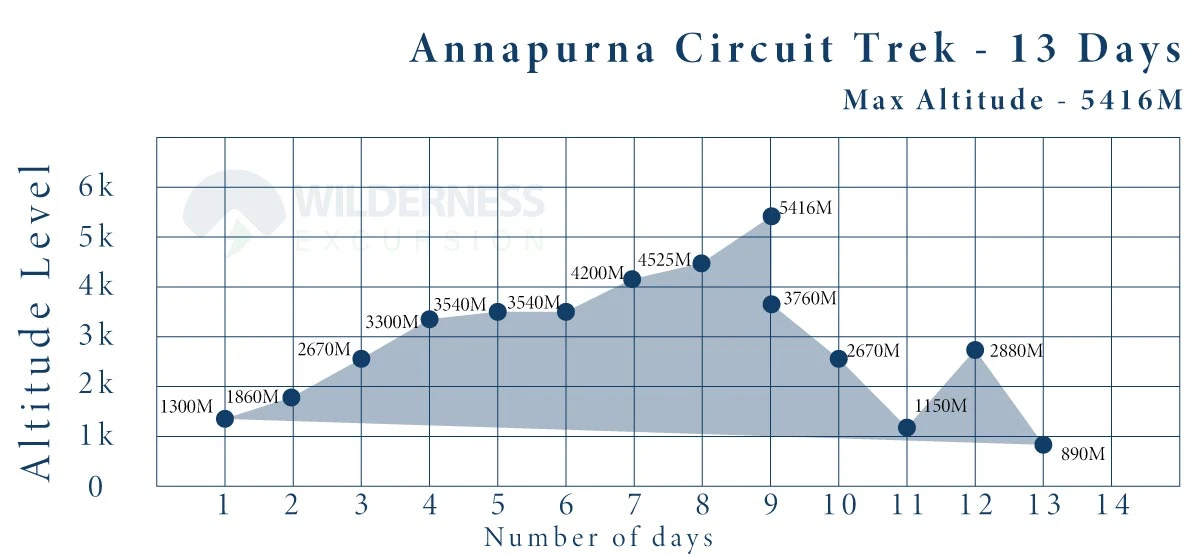
- A certified guide for the Annapurna Circuit Trek.
- 1 Night deluxe room in 3 star category hotel in Pokhara with breakfast.
- One shared high-altitude Sherpa porter for every two trekkers to carry your main backpack.
- Twin-sharing mountain lodge accommodations (teahouses) during the trek.
- Meals: 13 Breakfasts, 14 Lunches, and 13 Dinners throughout the trek.
- Public ground transportation to and from the trek as per the itinerary.
- Guide and porter fees, including all their expenses.
- Insurance for guides and porters as per government regulations.
- Required Annapurna Circuit trekking permits.
- Local taxes and documentation fees
- Transfers and meals in Kathmandu.
- Guided tour in Kathmandu, including monument entrance fees.
- Bar and beverage expenses during the trip.
- Hot showers and hot water during the trek.
- Personal expenses (laundry, phone calls, internet).
- Personal travel insurance and equipment.
- Emergency rescue operation charges.
- Tipping your guide and porter.
Check our published date! If it doesn’t match, we are happy to customize your tour perfectly to suit your interests and needs. Contact us for creating a unique travel experience for you
Trip Cost or Budgeting for Annapurna Circuit Trekking?
There are several aspects that vary the trip cost, including the season, number of participants, the length of the tour, and whether you just hire a guide or also include a porter to carry your main pack. Wilderness Excursion (WE) highly suggests hiring a porter shared between two trekkers to carry your pack, which helps you hike comfortably even where the air is very thin.
Typically, Annapurna Circuit Trek costs USD 1000 to 1500 per person for a fully supported and guided trek. Choosing a trekking agency also affects the trip cost. Our cost for the year 2025 and 2026 is still USD 999 per person, exclusive on a two or more people shared base, including expert guide, porter, permits, and meals, etc. A cost detail is provided in the inclusion and exclusion section.
What Permits are necessary for the trek?
You will need a conservation permit (ACAP, costs NPR 3000) and a TIMS (Trekkers’ Information Management System) Card: NPR 2000. Your trekking company, Wilderness Excursion, sorts out necessary trek permits as part of the Annapurna Trek Package inclusions.
Accommodation and Food:
We provide Accommodation and food along the circuit in teahouses. Typically, there will be shared room with shared room with basic amenities like, shared bathroom outside, no room heating. Trekkers are advised to bring their own sleeping bag or rent one in Kathmandu. Varieties of meals, and you can pick from the menu list. Served on the table what is ordered. One cannot expect the top rate in a fancy town. Fewer sources and being a remote area route make the service limited.
The Annapurna Circuit Trek: Best Time to Go / Can I trek in Monsoon (months of July and August)?
The best time to trek the Annapurna Circuit is during the spring (March to May) and autumn (September to November) seasons. These months offer stable weather, clear skies, and ideal temperatures for trekking.
Spring (March to May):
This is one of the most popular times for trekking. The weather is mild, with daytime temperatures ranging from 15°C to 20°C at lower altitudes and cooler temperatures at higher elevations. The rhododendron forests are in full bloom, creating a colorful landscape.
Autumn (September to November):
Autumn offers clear skies, mild temperatures, and excellent visibility of the mountains. This is the most popular season for trekking, with comfortable temperatures ranging from 10°C to 15°C at lower altitudes and colder temperatures at higher elevations.
Summer (June to August):
The monsoon season brings heavy rainfall, making trekking dangerous, particularly due to mudslides and river flooding. However, the landscape is lush and fully green, soaked in rain, and if you’re prepared for the weather, you can enjoy a quieter experience. In addition, both side of the upper part of Annapurna (from Manang and Marpha in the Mustang district) is said to be under the rain shadow. Check out our Nepal Monsoon Trek if you are considering going trekking in July and August.
Winter (December to February):
Winter can be challenging due to snow and freezing temperatures, especially at higher altitudes. But, it’s a great period if you are looking for solitude and fewer people on the trailhead.
Is the Annapurna Circuit Still Worth It? What is the impact of road construction?
Yes, the Annapurna Circuit is still worth it! Although parts of the route have been modified due to road construction, the trek still offers a rich cultural experience and breathtaking views of the Annapurna Massif and surrounding peaks.
The addition of roads in some sections means that the trek can now be modified, but the original route remains mostly intact, and trekkers can still experience the remote villages, dense forests, and high-altitude landscapes that make the Annapurna Circuit still famous.
Annapurna Circuit Trek for Beginners
While the Annapurna Circuit Trek is rated as a demanding trek, it can be completed by beginners with a reasonable level of fitness and a few months of preparation. The trek does not require technical climbing skills, but trekkers should be prepared for long days of walking, altitude changes, and basic hiking gear.
Important tips for beginners and elite trekkers doing the Circuit Trek:
- Get acclimatized: Spend at least one day in Manang to acclimatize and avoid altitude sickness.
- Physical training: Train by hiking on varying terrains, building stamina, and improving cardiovascular fitness.
- Stay hydrated: Drink plenty of water and avoid alcohol or excessive caffeine to reduce altitude-related risks.
- Hire guide: Hire a professional guide from a reputable company and take a porter to ensure you are properly supplied and are well-equipped for proper clothing and shoes.
- Important Gear: Do not forget the important gear, and bring adequate warm clothing
Most Essential Clothing and Checklist.
Wilderness Excursion suggests light packing but without missing the most important items, including base layers (long-sleeve tops and thermal underwear), quick-drying mid-layers (fleece or similar), and a down jacket is a must. Also include waterproof and windproof outer layers, a sun hat, and a warm hat for cold and windy days. Essential accessories are waterproof hiking boots, trekking socks, walking poles, a good sleeping bag, a good quality backpack, basic medicines and a first aid kit, and sun protection like sunglasses and sunscreen etc.
For comprehensive packing list information, check here!
Annapurna Circuit Trek is regarded LGBTQ+ friendly trek in Nepal, with strong regulations and strong laws against discrimination based on gender identity. But Nepal is a country where pubic displays of physical love are considered inappropriate, so please do follow the culture and tradition. Do not wear sun and beach clothes publicly while doing the Annapurna Circuit.
The best time to trek to Annapurna Circuit is just after the monsoon is over in September, Nepal’s monsoon season last till end of August; sometime it last until first week of September, monsoon rain clears up all the dust and rainy season brings greenery in low foothill, and view of white peaks are super when we have blue sky. No snow on higher places and Throng La Pass is easily crossable. September, October and November is peak time of Annapurna Circuit trek.
Second best time to trek to Annapurna Circuit is spring (Mar to May), though there are chances of soft rain and thunder storm, sky can be hazy sometimes in lower place however there are haze in the mountains. The benefit of trekking in April and May are warm temperature or even begging of June is okay to trek to Annapurna.
Trekking in winter (December to February) can be risk of snowfall, if snowfall is heavy then pass is blocked and you may have to turn back same way down to Besisahar. It is cold in winter, the night and early morning temperature can be around negative 14 degree Celsius outside the room. In Nepal we have no certain time if snowfall in Himalaya; thus it can be anytime in dry season (October to March)
Still you need to bear in mind that climate change and global warming are affecting our world and the weather condition in Himalaya changes fast so there are chances are rain and weather turn bad even in peak seasons.
And Annapurna Circuit trek is best alternative for those having vacation in summer (June to August). Upper part of Annapurna Circuit, mostly Manang Valley and Mustang is said be under the rain shadow zone. However; monsoon rain may affect the tails and roads / bridges are washed away sometimes, so it is always wise to allow few reserve days just in case bad weather, landslides and respectively flight delays that changes your plan.
If you develop AMS (Altitude Mountain Sickness) on the Annapurna Circuit Trek, we stop at the place while line of acclimatization at 3500 m (Manang) and descend to a lower altitude immediately if he symptoms do not disappear. Symptoms range from mild (headache, fatigue) to severe (vomiting, confusion, fluid in lungs or brain), and untreated AMS can be fatal. In this case, an immediate rescue must be arranged. All clients under ranking this Adventure with us should bring Travel Insurance that should cover air evacuation and medical treatment.
In the Annapurna Circuit Trek, there is WiFi internet in most of the teahouses along the route. The internet is slow and unreliable, and the mobile network becomes weak and unavailable sometimes, but surely, you can send text messages. NTC Sim is suggested if you consider carrying a local SIM.
Absolutely, you can rest sleeping bag and a down jacket in Kathmandu. Even buying gears is may be cheaper in Nepal compared to your home country. There are brands like North Face to good replicas.
Tipping is not mandatory and never insists that a client tip. Gratitude and tipping totally depend on the intuition of a client. It is only expected by the guide and porters. Just for an idea, people usually tip 10 to 15 % of the total value of the trip cost.
Wilderness Excursion suggests you to carry some cash in NPR (Rs) for your personal expenses that you may like to have beverages, donating in a monastery or else and even celebrate the trip successful. There are no banks and ATMS.
How difficult is the Annapurna Circuit trek? The question is raised in everyone’s mind before heading to the trip; it’s a fairly difficult trek for moderate trekkers. Trek used to start at Besi Sahar or Bulbule, but as road building has shortened the trek, thus people start the trek from Syange or Jagat. Our trek starts from Jagat, though you can drive further to Dharapani or even Koto and Thame. Starting the walk from Chame (2600 m) makes the trek shorter, but there are possible chances of altitude sickness because you have to go through 5416 meters high (Thorong La Pass). If you are fit and already acclimatized from the previous trek, then you can skip a few early days of trekking with a Jeep ride. Again, the Jeep ride is very adventurous on bumpy roads!
If you can allow the few extra days, you can add the Tilicho Lake side trip to the Annapurna Circuit Trek. Tilicho Lake is one of the main attractions of the Annapurna Circuit. The lake is situated at 4950 meters above sea level; it's one of the highest altitude lakes in the world considering the size. Similarly, Thorong La Pass, the highest point of the circuit, is considered one of the highest and widest pass in the world. Again, this trek is not for beginners and notice trekkers. If you are fit and young but have no such long-distance trekking experience in the Alps or Himalaya, pre-training like going to the gym or jugging regularly helps you to achieve the goal by starting the lower and allowing a few extra days to ensure you are well acclimatized and ready for the Thorong La pass.
The Annapurna Circuit trek typically takes about 12 to 21 days, departing from Kathmandu and driving to Besi Shahar it depending on where the transfer is used, with a stopover in Pokhara before getting back to the capital. The trail is moderate to fairly challenging and makes several river crossings over steel and wooden suspension bridges.
Annapurna Circuit - Absolutely amazing experience!
The Annapurna Circuit is a legendary trek, and my experience was made unforgettable by my fantastic group and the incredible team from Wilderness Excursion. Our lead guide, Garap, along with porters Naresh and Pasang,...
We had an absolutely amazing experience in the Annapurna Circuit – definitely one of the great treks that should not be missed by trekking passionate. We started the trek in mid-August, which is mid-monsoon time. But we were very lucky...
We just finished the Annapurna Circuit Trek in Nepal, organized by Wilderness Excursion. We are pleased and very delighted to complete this trek flawlessly, which is our life-changing adventure, the Annapurna Trek in Nepal’s stunning Himalayas. This iconic trek encircles...
.webp&w=3840&q=75&dpl=dpl_CcHazofUWtxxcPG7rXgNGJzBcmvR)
